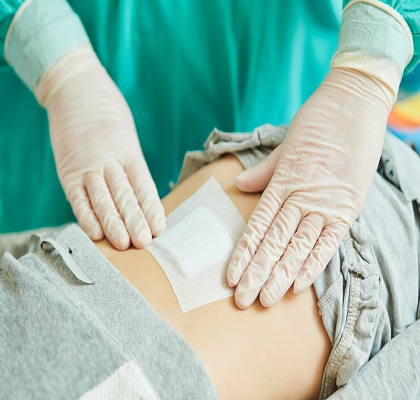Chronic Wounds Treatment - Abu Dhabi - Dubai
Chronic wounds are wounds that do not heal in a timely manner and often remain open for an extended period of time. Proper treatment of chronic wounds is essential to promote healing and prevent complications. Here are some commonly used treatment approaches for chronic wounds:
- 1. Wound Cleaning: Thoroughly cleaning the wound is crucial to remove debris, bacteria, and dead tissue. This can be done by gently irrigating the wound with a sterile saline solution or an appropriate wound cleanser.
- 2. Dressings: Various types of dressings are used to provide an optimal healing environment for chronic wounds. The choice of dressing depends on factors such as wound type, location, and amount of exudate. Some common types of dressings include foam dressings, hydrocolloid dressings, alginate dressings, and antimicrobial dressings.
- 3. Debridement: Removing dead or unhealthy tissue from the wound is essential for proper healing. Debridement can be done through different methods, including surgical debridement (performed by a healthcare professional), mechanical debridement (using dressings or tools to gently remove the dead tissue), enzymatic debridement (using specific enzymes to break down the necrotic tissue), or autolytic debridement (using the body's own enzymes and moisture to facilitate the removal of dead tissue).
- 4. Infection Control: Chronic wounds are prone to infection, which can hinder the healing process. If an infection is present, appropriate antimicrobial treatment, such as topical or systemic antibiotics, may be necessary. Regular monitoring and assessment of the wound for signs of infection are important.
- 5. Offloading: For chronic wounds on weight-bearing areas, offloading techniques may be employed to relieve pressure on the wound. This can involve the use of specialized footwear, orthotic devices, or other offloading techniques to reduce pressure and promote healing.
- 6. Compression Therapy: Compression therapy is used for chronic wounds associated with venous insufficiency or edema. It involves applying pressure to the affected area using compression bandages or stockings, which helps improve circulation and reduce swelling.
- 7. Advanced Therapies: In some cases, chronic wounds may require more advanced treatment options. These can include negative pressure wound therapy (NPWT), which uses a vacuum system to promote wound healing, or the application of bioengineered skin substitutes to stimulate tissue regeneration.
It's important to note that the treatment approach for chronic wounds should be tailored to the individual's specific needs. Consulting with a healthcare professional, such as a wound care specialist or a dermatologist, is recommended to determine the most appropriate treatment plan for a specific chronic wound.

